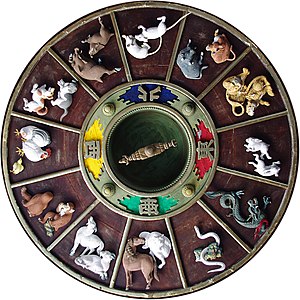Earthly Branches
It has been suggested that this article be merged with Heavenly Stems and Sexagenary cycle to Chinese cyclical signs. (Discuss) Proposed since July 2024. |
| Earthly Branches | |||||||||||||||||
|---|---|---|---|---|---|---|---|---|---|---|---|---|---|---|---|---|---|
 | |||||||||||||||||
| Chinese name | |||||||||||||||||
| Chinese | 地支 | ||||||||||||||||
| |||||||||||||||||
| Vietnamese name | |||||||||||||||||
| Vietnamese alphabet | Địa Chi | ||||||||||||||||
| Chữ Hán | 地支 | ||||||||||||||||
| Korean name | |||||||||||||||||
| Hangul | 지지 | ||||||||||||||||
| Hanja | 地支 | ||||||||||||||||
| |||||||||||||||||
| Japanese name | |||||||||||||||||
| Kanji | 地支 | ||||||||||||||||
| Hiragana | ちし | ||||||||||||||||
| |||||||||||||||||
The Earthly Branches (also called the Terrestrial Branches or the 12-cycle[1]) are a system of twelve ordered symbols used throughout East Asia. They are indigenous to China, and are themselves Chinese characters, corresponding to words with no concrete meaning other than the associated branch's ordinal position in the list. Cultural applications of the Branches include a dating system known as the sexagenary cycle, as well as astrology. They are associated with the ten Heavenly Stems in Chinese calendars, and in Taoist practice.
Overview[edit]
The twelve Earthly Branches are:
- 子
- 丑
- 寅
- 卯
- 辰
- 巳
- 午
- 未
- 申
- 酉
- 戌
- 亥
The branches each have specific names in languages of the Sinosphere—which include Chinese, Japanese, Korean, Vietnamese, and Mongolian. Branches are commonly used when counting in a manner similar to how letters are used according to their alphabetical ordering. In case of upper-case letters, the ⼝ 'MOUTH' radical may be added to the corresponding ordinal to denote an uppercase letter. In addition to the calendar months, each branch has been associated with several distinct cultural categories, including animals and the hours of the day, with some regional variation.
The Earthly Branches are used with the Heavenly Stems in Chinese calendars, and in Taoist practice. Many Chinese calendrical systems have started the new year on the second new moon after the winter solstice.
History[edit]
The earliest attested use of the Earthly Branches and Heavenly Stems is in recording cycles of days.[1] The ten Heavenly Stems provided names for the days of the week during the Shang dynasty (c. 1600 – c. 1050 BC). The Branches are at least as old as the Stems, with archaeological evidence suggesting they may actually be older.
There are several theories about the origin of the Earthly Branches prior to the advent of the historical record. One theory is that the Earthly Branches were adapted from observations of the planet Jupiter (歲星; Suìxīng; 'Year Star'), whose orbital period is roughly twelve Earth years long. Jonathan Smith has proposed that the first meanings of the earthly branches, predating the Shang, were phases of the moon, with the Heavenly Stems at that point referring to divisions of the ecliptic. After being adopted as a calendar these would have lost their clear lunar reference, permitting their re-purposing for Jupiter stations.[2]
In the context of Chinese cosmology becoming increasingly sophisticated during the Warring States period (c. 475 – 221 BC), the 12-, 10-, and 60-cycles began to be applied to units of time other than days.[1]
Directions[edit]

Though Chinese has words for the four cardinal directions, Chinese sailors and astronomers preferred using the 12 directions of the Earthly Branches, analogous to the use of o'clock for directions by English-speaking pilots. Since twelve points were not enough for sailing, 12 midpoints were added. Instead of combining two adjacent direction names, they assigned new names: for the four diagonal directions, appropriate trigram names of I Ching were used. For the rest, Heavenly Stems 1–4 and 7–10 were used. According to the five elements theory, east is assigned to wood, and the Stems of wood are 甲 (jiǎ) and 乙 (yǐ). Thus, they were assigned clockwise to the two adjacent points of the east.
Mariners like Zheng He (fl. 1405–1433) used 48-point compasses. An additional midpoint was called by a combination of its two closest basic directions, such as 丙午 (bǐngwǔ; 172.5°), the midpoint between 丙 (bǐng; 165°) and 午 (wǔ; 180°).
References[edit]
Citations[edit]
- ^ a b c Smith (2015).
- ^ Smith (2011), pp. 222.
Works cited[edit]
- Pankenier, David W. (2011), "Getting "Right" with Heaven and the Origins of Writing in China", in Li, Feng; Branner, David Prager (eds.), Writing and Literacy in Early China: Studies from the Columbia Early China Seminar, Seattle: University of Washington Press, pp. 19–50, ISBN 978-0-295-80450-7, JSTOR j.ctvcwng4z.7
- Pulleyblank, Edwin G. (1991), "The Ganzhi as Phonograms and their Application to the Calendar", Early China, vol. 16, pp. 39–80, doi:10.1017/S0362502800003837, ISSN 0362-5028
- Smith, Adam (2015), "Cyclical Signs", in Sybesma, Rint (ed.), Encyclopedia of Chinese Language and Linguistics Online, Brill, doi:10.1163/2210-7363-ecll-all, ISSN 2210-7363
- Smith, Jonathan M. (2011), "The Di Zhi 地支 as Lunar Phases and Their Coordination with the Tian Gan 天干 as Ecliptic Asterisms in a China before Anyang", Early China, vol. 33, pp. 199–228, doi:10.1017/S0362502800000274, S2CID 132200641
